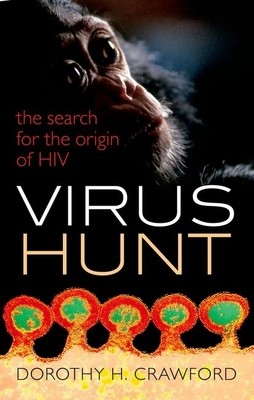
- We will send in 10–14 business days.
- Author: Dorothy H Crawford
- Publisher: Oxford University Press, USA
- ISBN-10: 0199641145
- ISBN-13: 9780199641147
- Format: 14.2 x 21.6 x 3.1 cm, hardcover
- Language: English
- SAVE -10% with code: EXTRA
Reviews
Description
In Virus Hunt, renowned virologist Dorothy H. Crawford takes us inside one of the great research quests of our time--the search for the origin of AIDS.
From hospital intensive care wards to research laboratories to the African rain forests, Crawford follows the trail of the virus back to its roots deep in Africa. We track wild monkeys and apes through the jungle--gathering their DNA via hair and feces samples--to discover from which primates HIV first jumped to our species, ultimately concluding that the most virulent strain, HIV-1, came from chimpanzees in Cameroon. We then time travel back to colonial Africa around the turn of the 20th century, when the virus first spread to humans. But even the rapidly mutating HIV could not survive in one person long enough to adapt to our immune system. Crawford shows that it may have been given the opportunity to adapt by being transmitted rapidly from one person to the next through unsterile syringes, ironically used during a campaign to wipe out disease by mass inoculation. The book then moves to Leopoldville (now Kinshasa), where Crawford describes the unique series of social upheavals,starting in the 1920s, that sparked epidemic levels of sexually transmitted diseases, allowed HIV-1 to begin its exponential growth. And when in the 1960s chance took the virus abroad to Haiti, from where it jumped to the United States, its pandemic spread began. Crawford tells a gripping story of brilliant scientific sleuthing, breakthrough discoveries, tragic errors, stubborn intractable mysteries, generous collaborations, and bitter disputes. And along the way, she conveys, with a light and engaging touch, a wealth of interesting observations about viruses, DNA, disease, immune systems, the very latest research methods, and of course HIV.
EXTRA 10 % discount with code: EXTRA
The promotion ends in 18d.22:29:12
The discount code is valid when purchasing from 10 €. Discounts do not stack.
- Author: Dorothy H Crawford
- Publisher: Oxford University Press, USA
- ISBN-10: 0199641145
- ISBN-13: 9780199641147
- Format: 14.2 x 21.6 x 3.1 cm, hardcover
- Language: English English
In Virus Hunt, renowned virologist Dorothy H. Crawford takes us inside one of the great research quests of our time--the search for the origin of AIDS.
From hospital intensive care wards to research laboratories to the African rain forests, Crawford follows the trail of the virus back to its roots deep in Africa. We track wild monkeys and apes through the jungle--gathering their DNA via hair and feces samples--to discover from which primates HIV first jumped to our species, ultimately concluding that the most virulent strain, HIV-1, came from chimpanzees in Cameroon. We then time travel back to colonial Africa around the turn of the 20th century, when the virus first spread to humans. But even the rapidly mutating HIV could not survive in one person long enough to adapt to our immune system. Crawford shows that it may have been given the opportunity to adapt by being transmitted rapidly from one person to the next through unsterile syringes, ironically used during a campaign to wipe out disease by mass inoculation. The book then moves to Leopoldville (now Kinshasa), where Crawford describes the unique series of social upheavals,starting in the 1920s, that sparked epidemic levels of sexually transmitted diseases, allowed HIV-1 to begin its exponential growth. And when in the 1960s chance took the virus abroad to Haiti, from where it jumped to the United States, its pandemic spread began. Crawford tells a gripping story of brilliant scientific sleuthing, breakthrough discoveries, tragic errors, stubborn intractable mysteries, generous collaborations, and bitter disputes. And along the way, she conveys, with a light and engaging touch, a wealth of interesting observations about viruses, DNA, disease, immune systems, the very latest research methods, and of course HIV.


Reviews